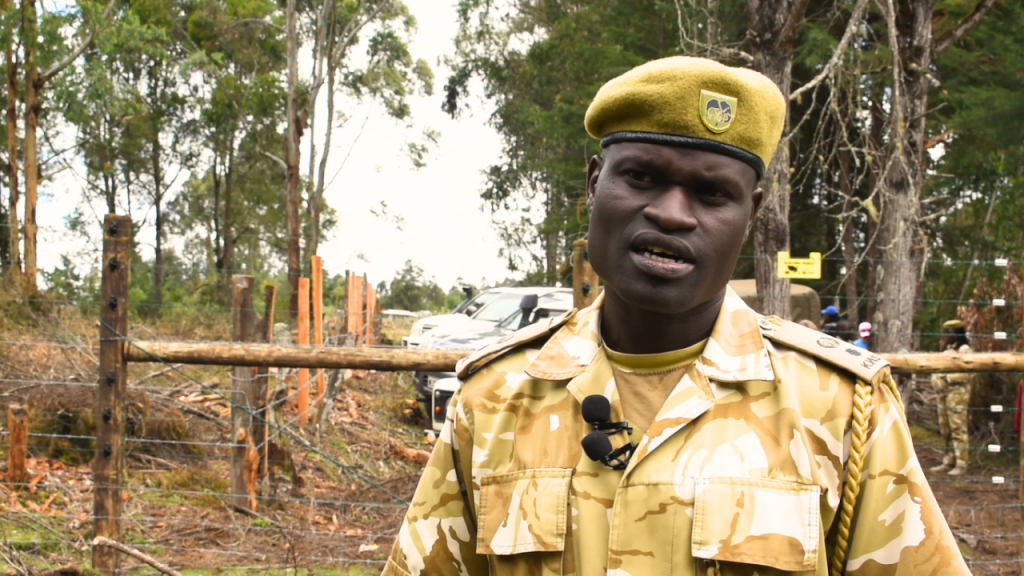Nyeri County, October, 2023 — When Chrispus Karua Kahungu was a school-going boy growing up in Mweiga ward in Kieni sub county, he and his friends could only hope to get home from school safely. The wildlife roamed freely in the area, and human-wildlife conflict was at its peak— it is with the construction of the Aberdare fence, that everything transformed.
This robust barrier, a section of a vast expanse of 450 km of fences strategically encircling vital areas where rainfall feeds into the nation’s life-giving rivers, not only transformed the lives of Kahungu and his family but also pioneered a new era for the entire community.

“In the past, elephants would devour everything in our farms,” Kahungu said. “Now, we are sure that when we plant, we will harvest something.”
As a small-scale farmer, Kahungu tends to his crops, livestock, and bees without fear, all within a stone’s throw of the Aberdare boundary— a land he once considered dangerous, with frequent encounters between wildlife and humans, resulting in crop destruction, illegal logging, poaching, and tragic human-wildlife fatalities.
The Resilience of Mt. Kenya’s Ecosystem
Thanks to the protective embrace of the electric fence, erected through a collaboration between the private sector, including the Kenyan environmental group Rhino Ark and the government, spearheaded by Kenya Wildlife Service and Kenya Forest Service— Kahungu and his neighbors now cultivate their land and send their children to school without the haunting specter of wildlife attacks.
“Over the years, the prevailing attitude of farmers towards these giants has shifted from fear to positivity.” Kahungu said, adding that they are looking at wildlife as one big family.
According to Mr. James Mwang’ombe, Head of Biodiversity Conservation and Management at the Kenya Forest Service, “Electric fences serve as a crucial management strategy, ensuring the safety of both wildlife and local communities.”
Mwangómbe said that these fences play a pivotal role in mitigating Human-Wildlife Conflicts. “Studies conducted across different regions have consistently shown that in areas where electric fences have been erected, there has been a significant boost in conservation efforts.”
He said that these initiatives have led to a substantial improvement in food security for nearby communities.”
“The enhanced agricultural opportunities within protected areas have led to a noteworthy increase in land prices,” Mwang’ombe added.
Electric fence operates by delivering a strong, brief, and memorable shock to deter wildlife. With a voltage reaching up to 9000 volts, it maintains a low current, ensuring that anyone who touches the wires receives a powerful shock without posing a lethal threat.
The structure that separates the gardens of the farmers from a section of the Aberdare park is a comprehensive high fence design, with eight strands and lock mesh wire, running in a straight line for as far as the human eye can see, along a dirt boundary road and behind a thick green shrub hedge.
“I see myself as a watchdog to wildlife,” Kahungu told Kass Media outside his homestead. He and his community members report suspicious activities, oversee the functionality of the electric fence, and ensure timely repairs when necessary.
The Human and Climate Impact on Elephants
The collaborative efforts of both the government and private sectors to conserve wildlife biodiversity underscore the mounting global concern regarding Human-Elephant Conflicts (HEC). Elephants, confined to shrinking habitats, increasingly encroach upon agricultural lands, and the impacts of a changing climate, leading to frequent crop raids and destruction.
Edward Waweru Mutito, from Mt. Kenya Conservation Forum, emphasizes how agriculture’s encroachment into traditional elephant habitat exacerbates the Human-Elephant Conflict, posing a significant threat to the long-term survival of elephants.
“I have grown up here, witnessing people encroaching on the wildlife corridors, areas where these animals used to thrive,” Mutito said. “In their attempt to reclaim their territory, elephants inadvertently disturb human settlements, leading to conflicts.”

Researchers say that climate change has introduced additional complexities to human-elephant interactions. It is said that shifting environmental conditions are altering the behavior and habitat of elephants and that erratic weather patterns have disturbed ecosystems, compelling wildlife, including elephants, to venture into human settlements in search of resources. This encroachment creates a dangerous cycle, posing threats to both livelihoods and safety, particularly in rural settings where communities rely on natural resources for survival.
In a recent incident, the homestead of James Wanjohi Kimani and his wife, Hellena Wambui, experienced an elephant attack on their home. During the late hours of the night, an elephant invaded their home in Kieni East, demolishing their house and consuming the stored cereals.
The couple, still shaken by the ordeal, now seek compensation for their losses. They argue that while Mt. Kenya area is fenced, the Laikipia region remains open, allowing elephants to venture out in search of food.

“We understand the need for conservation, but our lives have been severely disrupted. We hope for fair compensation to rebuild,” Wambui stated.
In response to this incident, Paul Omondi, the Deputy Warden for Mt. Kenya National Park, emphasized the government’s commitment to the compensation program and highlighted the ongoing efforts to mitigate such conflicts.
“Compensation is crucial to helping families affected by these incidents rebuild their lives. It’s a challenging situation, and we are continuously working on enhancing our strategies to minimize such occurrences,” he said.

Warden Omondi further reiterated the need for collaboration between communities, conservation organizations, and government agencies to create sustainable solutions.
“Our goal is to find a balance where both humans and wildlife can coexist peacefully. Education, awareness, and responsive action are key components of this ongoing effort,” he added.
In mid this year, the Kenyan government allocated Kshs. 908 Million as part of its annual compensation program for families affected by wildlife-related incidents, including injuries, property damage, and loss of life nationwide.
Announced by Penina Malonza, the former Cabinet Secretary of the Ministry of Tourism, Wildlife & Heritage in Kenya, the disbursement represents a portion of the overall claims, which are expected to increase from Kshs. 2.8 billion to approximately Kshs. 5.1 billion.
While victims await compensation, researchers worldwide continue to conduct studies aimed at understanding the complexities of the changing environment and its impact on human-wildlife coexistence.
The Science of Human-Elephant Conflict
A study published by Springer Nature (SN) Appliance Science highlighted the critical issue of increased agriculture and settlements posing a severe threat to the ecological sustainability of elephant habitats (SN Applied Science, 2021). The study demonstrated that these factors lead to habitat fragmentation, human encroachment, and intense pressure and competition for resources within elephant habitats.
Scientific studies have shown that African elephants, known for their migratory patterns and ability to trace previous routes, face significant challenges when their natural corridors are obstructed. Researchers from the University of Nottingham and British Geological Survey (BGS) conducted a study assessing mineral status in elephants, using samples like toenails, tail hair, and feces (Scientific studies, 2020).
These non-invasive methods provide valuable insights into elephants’ dietary needs and movement patterns. The information gained is instrumental in managing human-elephant conflicts and ensuring their coexistence. This data is also being utilized for further studies focusing on the home range of elephants in South Africa.
Despite numerous scientific efforts to understand Human-Elephant conflicts and alternative mitigation measures, real-world impact continues to affect human and wildlife communities. With 65% of Kenya’s wildlife population living outside protected areas, conservationists agree that integrated efforts, including the implementation of Conservation Education programs, are crucial to effectively manage these conflicts.
Conservation Education Initiatives
In 2019, Sergeant Fridah Wanyonyi, stationed at Mt. Kenya National Park began conducting conservation education programs in nearby schools. These efforts quickly expanded, reaching communities’ homesteads.
Sergeant Wanyonyi now oversees a group of conservation-aware children, whom she affectionately calls ‘Junior Wardens.’

“These young advocates play a crucial role in educating their families about the significance of wildlife conservation, fostering a sense of responsibility and empathy for the environment,” reiterated Sergeant Wanyonyi.
Reiterating her sentiments, Emmah Wairimu Maina, a teacher from Bondeni Primary School, emphasized, “It’s crucial that the younger generation understands the delicate balance between humans and wildlife.”
Speaking from the School in Mweiga ward, Emmah stressed that by instilling a sense of responsibility and empathy for the environment, “we hope to pave the way for coexistence.”
She highlighted the support from Rhino Ark, enabling them to provide comprehensive conservation education to pupils. Thanks to their resources and programs, students not only learn about fence conservation and environmental preservation but also enhance their academic skills.
The initiatives extend beyond classrooms; students actively participate in various activities, including racing events, writing competitions, and tree planting exercises.

Teacher Emmah mentioned, “These outdoor educational activities make the students excited to participate in conservation efforts.”
“Understanding the essence of the electric fence shielding their schools from the wilderness is pivotal,” said Adams Mwangi, Fence and Community Management Officer from Rhino Ark. He said that when students grasp the historical context behind these barriers and engage in activities practically, conservation education becomes more than just knowledge—it becomes a legacy for the generations yet to come.

Community Engagement and Empowerment
The effectiveness of the Aberdare Fencing project has spurred similar initiatives across various areas in the region, offering support, education, and employment to neighboring communities.
Currently, a phase five fencing project is ongoing in Kirima, found in Kabaru ward, Kieni East sub-county. The project is being supported by various stakeholders among them, Kenya Wildlife Service, Kenya Forest Service, Community Forest Associations (Kabaru, Hombe, and Narumoru), and Rhino Ark Charitable Trust.
Present at the inaugural Kirima Phase Five fencing project were the women from Car 19, widely recognized as the Bush-babes.
Under the leadership of Petra Somen, this all-female team has actively participated in the Rhino Charge event for 13 years.
Petra shared her enthusiasm about the project stating that “We race for such initiatives. Our aim is to continue supporting the work Rhino Ark is doing and bring more sponsorship on board for the better efforts of conserving our environment and supporting the community around them.”
She highlighted that the CAR 19 team utilizes their platform to raise awareness about environmental conservation.
“It has been an honor to continually show up for this worthwhile cause,” Petra expressed passionately.

At the site, the Bush-babes had the opportunity to help erect fences, showcasing their hands-on dedication to preserving wildlife habitats.
They revealed that, through their relentless fundraising efforts, they have raised about 26 million Kenyan shillings in support of conservation initiatives.
The Concerns Surrounding Electric Fences
“Electric fences have undoubtedly brought several benefits, but their impact on wildlife, especially faunas, must be carefully addressed,” voiced Mr. James Mwang’ombe, Head of Biodiversity Conservation and Management at the Kenya Forest Service.
He expressed concerns about limited wildlife movement, leading to fragmented fauna populations.
“Restricted movement can result in genetic loss and reduced variability, potentially leading to species extinction,” Mwang’ombe said. “ While some areas like Mt. Kenya has integrated escape routes for elephants, ensuring their free movement to Lewa, this hasn’t been a consideration in other places.”

Mwang’ombe stressed the necessity of finding a balance to minimize adverse consequences.
With education as its foundation and collaborative initiatives in place, conservationists believe in a promising future where humans and wildlife can coexist harmoniously. Stories like Chrispus Karua Kahungu highlight this possibility.
“We’ve come to realize that living in harmony with nature is possible,” Kahungu explained. “By working together, we protect our homes and the wildlife habitat.”
The sounds of construction echoed through the air with ongoing work on the electric fence signifying the ongoing efforts in managing human-wildlife coexistence, even as the sun set over Mt. Kenya, casting a warm glow on the landscape.





